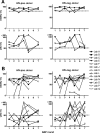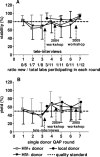Substantial improvements in performance indicators achieved in a peripheral blood mononuclear cell cryopreservation quality assurance program using single donor samples
- PMID: 17050740
- PMCID: PMC1797705
- DOI: 10.1128/CVI.00214-06
Substantial improvements in performance indicators achieved in a peripheral blood mononuclear cell cryopreservation quality assurance program using single donor samples
Abstract
Storage of high-quality cryopreserved peripheral blood mononuclear cells (PBMC) is often a requirement for multicenter clinical trials and requires a reproducibly high standard of practice. A quality assurance program (QAP) was established to assess an Australia-wide network of laboratories in the provision of high-quality PBMC (determined by yield, viability, and function), using blood taken from single donors (human immunodeficiency virus [HIV] positive and HIV negative) and shipped to each site for preparation and cryopreservation of PBMC. The aim of the QAP was to provide laboratory accreditation for participation in clinical trials and cohort studies which require preparation and cryopreservation of PBMC and to assist all laboratories to prepare PBMC with a viability of >80% and yield of >50% following thawing. Many laboratories failed to reach this standard on the initial QAP round. Interventions to improve performance included telephone interviews with the staff at each laboratory, two annual wet workshops, and direct access to a senior scientist to discuss performance following each QAP round. Performance improved substantially in the majority of sites that initially failed the QAP (P = 0.002 and P = 0.001 for viability and yield, respectively). In a minority of laboratories, there was no improvement (n = 2), while a high standard was retained at the laboratories that commenced with adequate performance (n = 3). These findings demonstrate that simple interventions and monitoring of PBMC preparation and cryopreservation from multiple laboratories can significantly improve performance and contribute to maintenance of a network of laboratories accredited for quality PBMC fractionation and cryopreservation.
Figures




References
-
- Betts, M. R., J. P. Casazza, and R. A. Koup. 2001. Monitoring HIV-specific CD8+ T cell responses by intracellular cytokine production. Immunol. Lett. 79:117-125. - PubMed
-
- Currier, J. R., E. G. Kuta, E. Turk, L. B. Earhart, L. Loomis-Price, S. Janetzki, G. Ferrari, D. L. Birx, and J. H. Cox. 2002. A panel of MHC class I restricted viral peptides for use as a quality control for vaccine trial ELISPOT assays. J. Immunol. Methods 260:157-172. - PubMed
-
- Disis, M. L., C. dela Rosa, V. Goodell, L. Y. Kuan, J. C. Chang, K. Kuus-Reichel, T. M. Clay, H. K. Lyerly, S. Bhatia, S. A. Ghanekar, V. C. Maino, and H. T. Maecker. 2006. Maximizing the retention of antigen specific lymphocyte function after cryopreservation. J. Immunol. Methods 308:13-18. - PubMed
-
- Dyer, W. B., H. Kuipers, M. W. Coolen, A. F. Geczy, J. Forrester, C. Workman, and J. S. Sullivan. 2002. Correlates of antiviral immune restoration in acute and chronic HIV-1 infection: sustained viral suppression and normalisation of T cell subsets. AIDS Res. Hum. Retrovir. 18:999-1010. - PubMed
Publication types
MeSH terms
LinkOut - more resources
Full Text Sources
Miscellaneous

